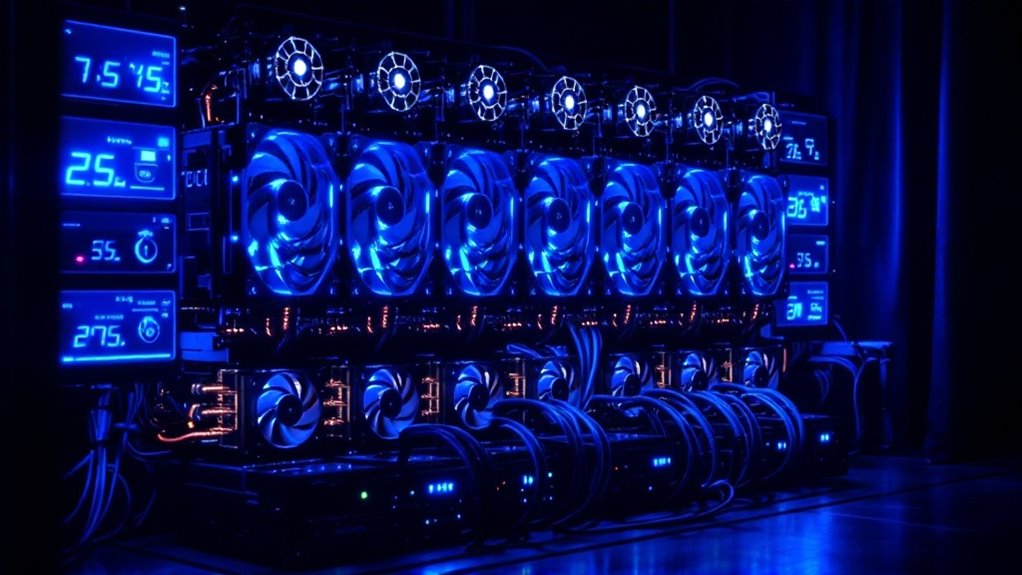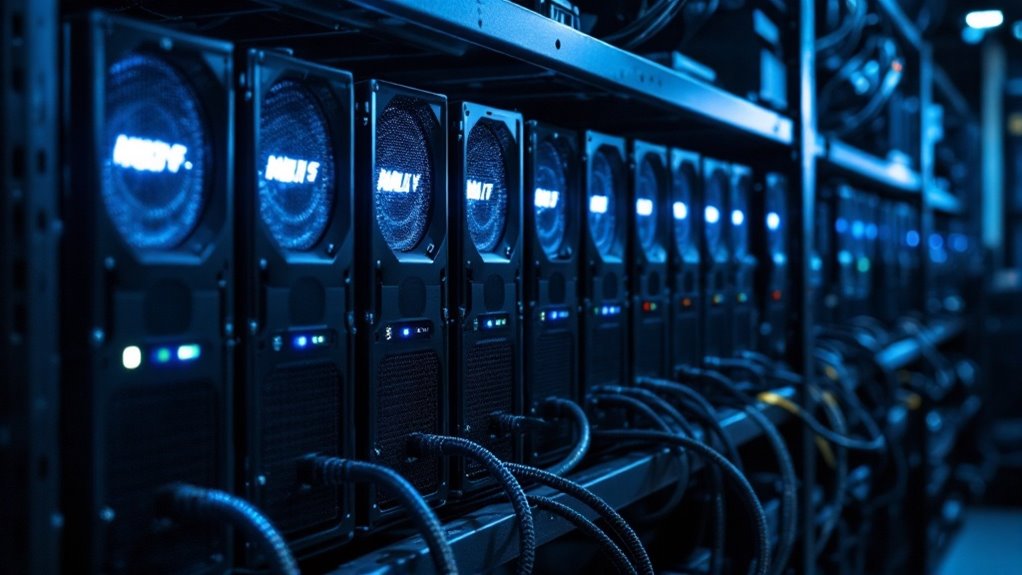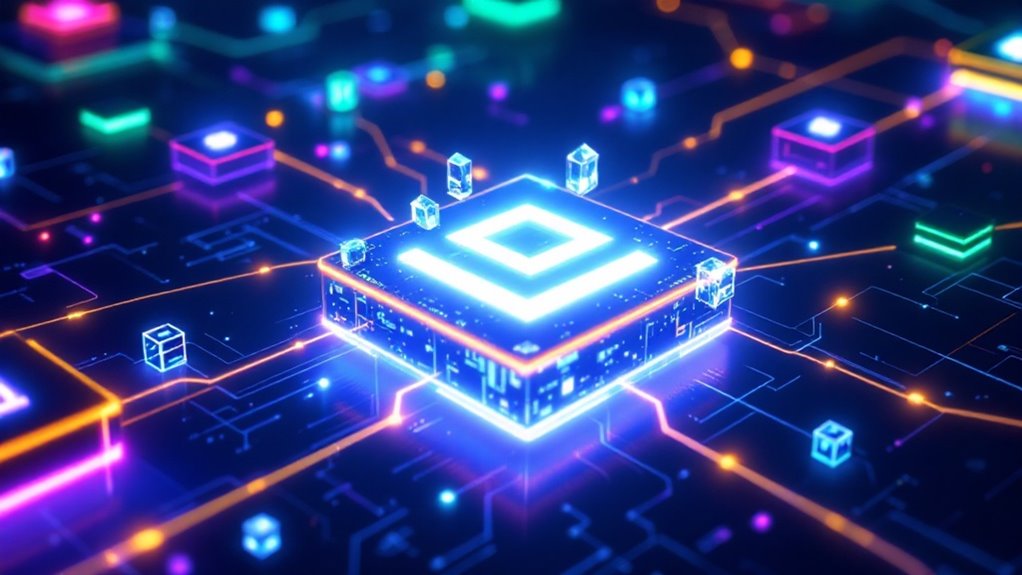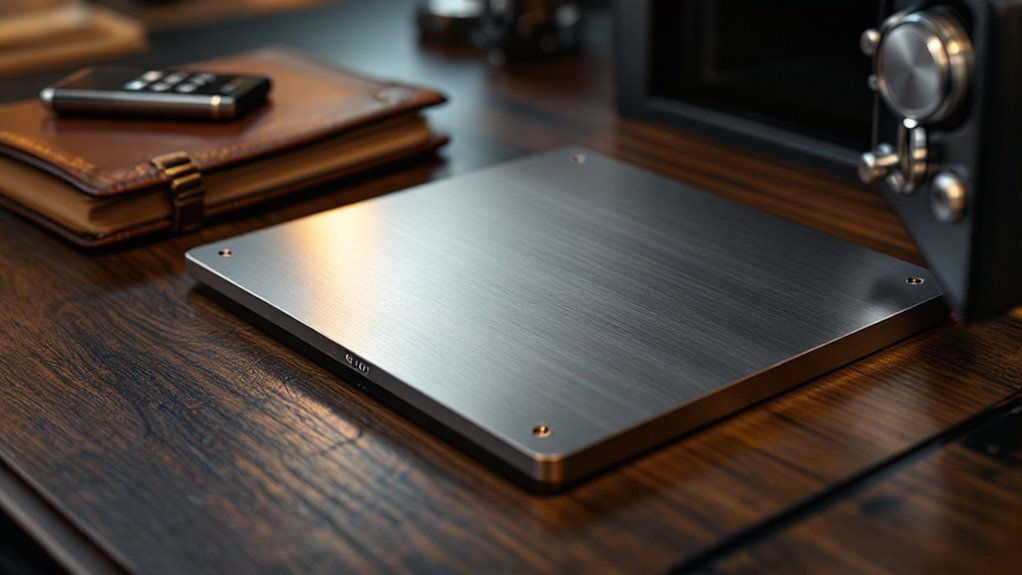Cryptocurrency mining hardware transforms electricity into digital wealth through sophisticated computing equipment. Modern mining operations rely primarily on specialized ASIC machines like the Bitmain Antminer S21 Pro, which can achieve 234 terahashes per second, or powerful GPUs for alternative cryptocurrencies. Setting up a mining operation requires careful consideration of power consumption, cooling systems, and local electricity rates. While garage-based setups once dominated, today's industrial-scale facilities showcase how far this digital gold rush has evolved. The deeper story of mining hardware reveals an fascinating intersection of innovation and necessity.

The gleaming arrays of crypto mining hardware represent the industrial backbone of the cryptocurrency revolution, where raw computing power transforms electricity into digital wealth. Like modern-day prospectors, miners now wield sophisticated machines instead of pickaxes, with ASICs and GPUs humming away in temperature-controlled rooms across the globe. The gentle whir of cooling fans provides a constant reminder that this digital gold rush runs on silicon and electricity rather than shovels and streams.
At the heart of this technological evolution lie several distinct categories of mining equipment, each with its own strengths and limitations. ASICs, the specialized workhorses of the industry, dominate Bitcoin mining with machines like the Bitmain Antminer S21 Pro churning out an impressive 234 terahashes per second. The recently released Bitmain Antminer S21 Hyd 335T achieves an unprecedented 335 terahashes per second. These purpose-built machines stand in stark contrast to the more versatile GPUs, which still find their niche in mining alternative cryptocurrencies and maintaining decentralization. The superior energy efficiency of ASICs makes them the clear choice for serious Bitcoin mining operations. This competitive process helps prevent double-spending and ensures the network's security.
The choice of mining hardware often becomes a delicate dance between power consumption and computational output. Modern ASIC miners, while incredibly efficient at their designated tasks, consume enough electricity to power small households. The Bitdeer Sealminer A2, for instance, draws 3,729 watts while racing to solve complex mathematical puzzles, a reflection of the energy-intensive nature of cryptocurrency mining.
Cryptocurrency miners walk a tightrope between raw computational power and energy costs, as modern machines devour electricity with industrial appetite.
Setting up a mining operation requires more than just the primary computing units. A successful mining facility resembles a digital orchestra, where power supplies, cooling systems, and network equipment work in harmony to support the main performers. Miners must carefully consider their local electricity rates, ventilation requirements, and even zoning laws before initiating their crypto mining journey.
The evolution of mining hardware continues at a rapid pace, with manufacturers like Bitmain, MicroBT, and Canaan competing to produce more efficient machines. This technological arms race drives innovation while highlighting the industry's growing maturity.
As cryptocurrency mining shifts from garage operations to industrial-scale facilities, the equipment that powers this digital economy becomes increasingly sophisticated, marking the steady progression from crypto's wild west days to a more established industrial landscape.
Frequently Asked Questions
How Much Electricity Does a Typical Mining Rig Consume per Month?
A typical mining rig consumes between 720-1,440 kilowatt-hours (kWh) per month, based on continuous operation of systems using 1,000-2,000 watts of power running 24 hours a day, seven days weekly.
Can I Mine Cryptocurrencies Using My Laptop's Built-In Graphics Card?
While technically possible, mining cryptocurrencies on a laptop's built-in graphics card is not recommended. It generates excessive heat, offers minimal profits, and risks damaging the laptop's components through continuous high-intensity operations.
What Happens to Mining Hardware After It Becomes Obsolete?
Obsolete mining hardware typically becomes e-waste due to its singular purpose. Some units are recycled for precious metals, while others are refurbished or repurposed. Many are properly disposed of to prevent environmental contamination.
Is It Possible to Mine Different Cryptocurrencies With the Same Hardware?
Mining different cryptocurrencies with the same hardware depends on the equipment type. GPUs offer versatility for multiple coins, while ASICs are limited to specific algorithms. CPU mining works for select ASIC-resistant cryptocurrencies.
How Long Does Cryptocurrency Mining Hardware Typically Last Before Needing Replacement?
ASIC mining hardware typically lasts 3-5 years under normal conditions. With proper maintenance and ideal operating environments, some units can function up to 10 years, though efficiency decreases over time.









